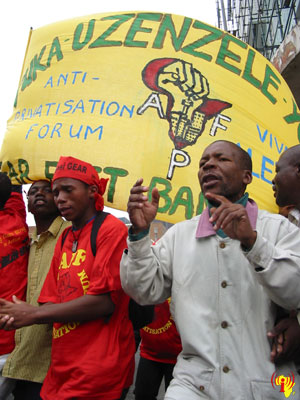40,000 March against the Johannesburg Summit
40,000 people defied growing police repression in South Africa on 31 August, marching five miles from Alexandra township to Sandton, location of the World Summit for Sustainable Development.
 Some of the demo’s slogans were those of the anti-capitalist movement worldwide - “another world is possible” and “our world is not for sale.” Marchers raised international issues, condemning US policies, demanding “Hands Off Iraq!” and showing solidarity with the Palestinians, a section chanting “Amandla! Intifada!” Protesters from the Soweto Electricity Crisis Committee addressed local issues such as evictions and electricity disconnections, and the Landless People’s Movement wore red T-shirts calling for land, food and jobs.
Some of the demo’s slogans were those of the anti-capitalist movement worldwide - “another world is possible” and “our world is not for sale.” Marchers raised international issues, condemning US policies, demanding “Hands Off Iraq!” and showing solidarity with the Palestinians, a section chanting “Amandla! Intifada!” Protesters from the Soweto Electricity Crisis Committee addressed local issues such as evictions and electricity disconnections, and the Landless People’s Movement wore red T-shirts calling for land, food and jobs.
Support from Townships
The march route led from the deprived Alexandra township, where residents welcomed thirsty marchers with drinks, to the exclusive Sandton area, symbolising the worldwide divide between rich and poor. Because of the long and hilly route and the heat, buses were arranged for elderly marchers, though many insisted on completing the march on foot.
Police Ready to Provoke Violence
The demonstrators were good-natured and peaceful, though the threat of repression was plain. In the words of BBC Online: “There was a highly discordant note - a very heavy police presence throughout the length of the route. Most were armed, with batons, sidearms, shotguns or stun grenades, and sometimes a combination. A sight to amaze those who fought against apartheid were the hated Caspars, huge armoured vehicles topped by steel-helmeted soldiers manning machine guns. The Caspars used to roar into the townships and terrify the inhabitants at will. It looked as if they were ready to do exactly the same again.”
Harassment of Activists in Last Two Weeks
This is only one example of the repression protesters have faced - more than five hundred people had been arrested in the previous two months, in events horribly evocative of the apartheid era. A hundred anti-apartheid veterans were arrested on 17 August on their way to a demonstration and held for over a week. They went on hunger strike and were tear-gassed in their cells. Central Johannesburg jail, where they are held, was notorious under apartheid for torture and killing.
On 21 August the Landless People’s Movement marched on the office of the Premier of Gauteng, the province around Johannesburg. Indymedia South Africa reported that “The atmosphere on the march was strong and open, with people of all ages, with people singing and dancing and women breastfeeding their children.” Around a hundred people were arrested, including leading organisers of the anti-WSSD protests, when they refused to disperse. Many people were arrested the following day when they went to the police station to organise legal assistance. On 25 August police fired stun grenades at a peaceful candlelit demonstration at Witwatersrand University.
Movement in Buoyant Mood
The repression has failed to demoralise the movement, however. SA Indymedia reported that solidarity protests took place the week before the 31 August in Toronto, Buenos Aires and Mauritius, and also mentioned GR’s own London protest planned for 2 September.
The mood is buoyant: in the words of Indymedia South Africa: “31 August 2002 will go down in history as the beginning of a new movement in South Africa and the world - a movement that asserts the power of people over delegated leaders and representatives in government, NGOs, political parties and the bureaucratised trade union movement; the power of people over profits and the interests of the rich; the power of collective, democratic action in the creation of an other world outside of capitalism.”







